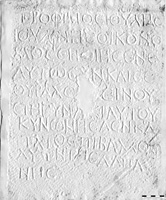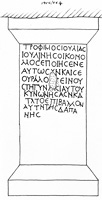 MAMA XI 48 (Eumeneia)
MAMA XI 48 (Eumeneia) 
Funerary bomos of Trophimos and Severa
- Type of monument:
- Funerary bomos.
- Location:
- Serbanşah (Eumeneia): in the foundation of a wall.
- Description:
- Plain bomos of whitish limestone, buried above.
- Dimensions:
- Ht. 0.93+; W. 0.47 (upper moulding), 0.35 (shaft), 0.47 (lower moulding); Th. 0.47 (lower moulding); letters 0.022-0.030.
- Record:
- Squeeze; line drawing; MB notebook copy (1956/56).
- Publication:
- None.
- Date:
- Roman imperial period.
Τρόφιμος Ἰουλίας
Ἰουλινῆς οἰκονό-
μος ἐποίησεν ἑ-
αυτῷ σὺν καὶ Σε-
5ου⟨ή⟩ρᾳ Λο[ν]γ̣είνου
{ς} τῇ γυνα[ι]κὶ αὐτοῦ
κυνωσησάσ⟨ῃ⟩ κα-
τ⟨ὰ⟩ τὸ ἐπιβάλλον
αὐτ⟨ῇ⟩ τῆς δαπά-
10νης.
Line 5: ΟΥΡΑ.
Lines 7-8: ΚΥΝΩΣΗΣΑΣΝ ΚΑ|ΤΛ.
Line 9: ΑΥΤΝ.
Trophimos, agent of Iulia Iuliana, made (this tomb) for himself along with Severa, daughter of Longinus, his wife, who joined with him in taking her share of the expense (for the construction of the tomb).





Trophimos was the local estate-manager (οἰκονόμος, vilicus) of a land-owner by the name of Iulia Iuliana. Her name is not distinctive, and she cannot be identified with any confidence. A Iulia Iuliana is known as a member of a family possessing the Roman citizenship at Sebaste in the late first century AD (Ramsay, Phrygia II 602-3, no. 475); another was honoured at Thyateira in Lydia in the late second century AD (TAM V 2, 963); a third (SEG 4, 407, restoring Ἰουλίαν Ἰου[λιανήν]; PIR2 I 672) was the daughter of Sex. Iulius Maior of Nysa (PIR2 I 397; Habicht 2005), consul in AD 126.
The fact that Trophimos has no patronym strongly implies that he was a slave, while his wife seems to have been of free status. This disparity in status between husband and wife may be the explanation for the curious expression in lines 7-10; for the phraseology here, compare MAMA IV 208 (Apollonia), [ὁ δεῖνα Ἀπολ]λωνίου ἰδίᾳ γυναικὶ μν[ήμης χάριν· Μ]εννέας Ἀπολλωνίου συνεδ[απ]ά̣νησα.
The only other inscription recorded at Serbanşah is Drew-Bear 1978: 79-80, IV 11 (SEG 28, 1157).